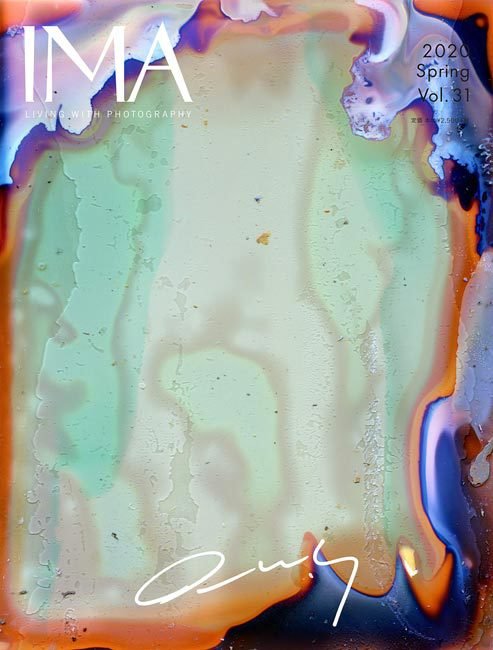Profile of Hannah Darabi
IMA, Vol. 31, Spring 2020
For IMA magazine’s “Collector’s Eye” column, I wrote a profile of Hannah Darabi and her collection of Iranian photo-books focusing on the Revolution.
In recent years the increased recognition of the photobook’s role in the development of twentieth century photography has led to a number of “books on books”—anthologies that explore the photobooks of a particular country and era. In 2018, the Iranian artist Hannah Darabi published a book exploring the books produced during the Iranian Revolution* and its immediate aftermath. While Darabi’s book, Enghelab Street, a Revolution through Books: Iran 1979–1983 (Le Bal/Spector Books, 2018), seems on first glance to belong to the growing “book on books” genre, it was conceived in an altogether different way.
Darabi has been based in Paris since 2007 but was born and raised in Tehran where she studied photography from 2001 to 2005. When we met in her studio and apartment in northwest Paris, she explained, “As an artist I’m very interested in the photobook and the artist book as a medium.” In her artistic practice, Darabi frequently combines her own photographs with other materials including postcards, documents, film stills and images from different publications. This interest in using documents and archival materials is at the root of her collection.
“In 2014–15 I was doing a project on the city of Tehran,” she recalls, “and I used to go to second-hand bookshops to find material.” This is how Darabi found the first photobook that gave her the idea to build a collection of Iranian photobooks from the era of the Iranian Revolution: Shahrokh Hatami’s Allah Akbar documenting the Ayatollah Khomeini’s rise to power.
Leafing through its pages, it was clear to Darabi that the person who made this book “had a real understanding of the possibilities of the photobook.” She thought to herself, “where there is one, there must be more,” and began to search for other photobooks from the period. “I began with an interest and curiosity for photobooks and the way they were made,” she recalls, “but because this was the era of the Revolution and the Iran–Iraq War, photographers were obsessed by these two subjects.” As a result the books in the collection almost exclusively focus on the Revolution and the ensuing war.
She began to acquire books in her native city of Tehran. “I wanted the books to come specifically from Iran,” she told me, “because they represent traces of the revolution which are still there in Iran.” But her search proved to be difficult. Although she was a student during the relatively open reformist period of the early 2000s, she says “I don’t remember ever seeing an Iranian photobook at that time. So, in my mind, there were none.” There were very limited reference materials or libraries cataloguing these publications and many of the photobooks had disappeared in the many years of war and censorship following the Revolution. Despite large print runs—one book, Days of Blood, Days of Fire (1979), was printed in two editions totalling over 30,000 copies—most of these books are now incredibly hard to find.
Darabi eventually met Alireza Ferdowsi Zadeh, a young Iranian man who was a follower of Khomeini and who collected books on the Revolution and the Iran–Iraq War and who helped her to discover a number of books.
Her motivation for building this collection was clear: “I had been taught the history of this time in a very fragmented, biased way in school. I would hear different versions of this history from my parents, my friend’s parents and later on in books published in Europe or in the United States. My desire was to develop my understanding of the history of the Iranian Revolution as a child of the post-revolutionary period.”
As an artist who has a particular interest in the photobook, Darabi saw the collection as raw material for an artistic project. “I wanted to create an artwork which would represent my perspective as an artist of the post-revolutionary era.” The project became the book Enghelab Street—Enghelab (Revolution) Street is located in the center of Tehran and is an important cultural area with many bookshops.
Enghelab Street features around eighty books from Darabi’s collection structured in two parts: 38 photobooks from the Revolution and its aftermath, from independently produced books to government propaganda publications; followed by a selection of “white covers”, illicit publications (from political books to foreign novels) produced by small, independent publishing houses.
Darabi decided to provide visuals and information on each book but also to integrate them and the imagery they contain into a broader visual context in a final chapter entitled Reconstructions. “For me each book is a moment of the history of the revolution,” she explains, “so I chose one spread from each book from which to tell the history of the revolution. Each of these spreads communicates with another image (postcards, images from films I saw growing up in Teheran…).”
Enghelab Street received both the Arles Historic Photo Book Award and the Paris Photo - Aperture Foundation Photography Catalogue of the Year Award in 2019 and Darabi now considers her artistic project on the collection to be finished. But she continues to search for books to add to her collection which provides a unique perspective on this turning point in her country’s history.
* The Iranian Revolution of 1978–79 was a series of events that led to the government of Mohammad Reza Pahlavi, the last monarch of Iran, being overthrown and replaced with an Islamic republic under the Ayatollah Khomeini in February 1979.
